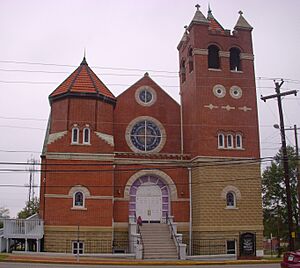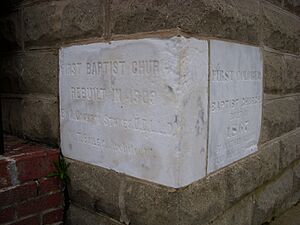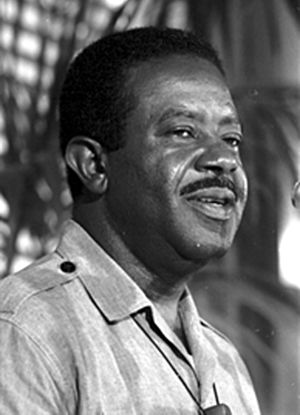First Baptist Church (Montgomery, Alabama) facts for kids
Quick facts for kids First Baptist Church |
|
|---|---|

Front of the First Baptist Church
|
|
| Location | North Ripley Street, Montgomery, Alabama |
| Country | United States |
| Denomination | Baptist |
| Website | http://www.firstbaptistchurchmontgomery.com |
| History | |
| Founded | 1866 |
| Architecture | |
| Architect(s) | Walter T. Bailey |
| Style | Romanesque Revival |
| Completed | 1910–1915 (present building) |
The First Baptist Church on North Ripley Street in Montgomery, Alabama, is a very important historical place. It is also known as the Brick-A-Day Church. This church was started in downtown Montgomery in 1867. It was one of the first black churches in the area.
It gave African-Americans a place to worship where they were treated equally. Before this, they faced unfair treatment and discrimination at other churches in the city. In its early years, the First Baptist Church became one of the largest black churches in the Southern United States. It grew from hundreds to thousands of members.
Later, in the 1950s and 1960s, the church was a key meeting spot for the Civil Rights Movement. It is linked to important leaders like Ralph Abernathy. It also played a role in the 1955-56 Montgomery bus boycott and the Freedom Rides in May 1961. The church was added to the Alabama Register of Landmarks and Heritage in 2000. It was also listed on the National Register of Historic Places in 2024.
Contents
History of the Church
The church community first came together in 1866. Before this, many of its early members, who were enslaved, had attended the First Baptist Church on Perry Street. At that church, Black people were only allowed to sit in the balcony. They could not be on the main floor unless they were cleaning.
In 1867, about 700 African-American members left the Perry Street church. They marched to an empty lot at Ripley Street and Columbus Street. There, they declared themselves the "First Baptist Church (Colored)." This became the first "free Negro" institution in Montgomery. The first building was made of wood and faced Columbus Street. It was called the Columbus Street Baptist Church.
The first pastor was Nathan Ashby. He also became the first president of the Colored Baptist Convention in Alabama. This group was founded at his church in December 1868. Pastor Ashby retired in 1870 due to illness. J.W. Stevens briefly served as pastor after him.
In 1871, James H. Foster became the pastor for twenty years. He helped the church grow from a few hundred members to several thousand. His successor, Pastor Andrew Stokes, helped even more people join the church.
Building the "Brick-A-Day Church"
The first wooden church building was destroyed by fire. Between 1910 and 1915, the church was rebuilt. The new building now faced east, toward Ripley Street. Pastor Stokes led this rebuilding effort.
Members of the church were asked to bring one brick each day to help with construction. This is how the church got its famous nickname, the "Brick-A-Day Church." The building was designed in the Romanesque Revival style. The architect was Walter T. Bailey from Tuskegee University.
The Church and Civil Rights
From 1952 to 1961, the church was led by Ralph Abernathy. He was a civil rights leader and a close friend of Martin Luther King Jr.. Dr. King preached nearby at the Dexter Avenue Baptist Church from 1954 to 1960.
During the Montgomery bus boycott (1955–1956), First Baptist Church was a key place for large meetings. Pastor Abernathy was a trusted friend of Edgar Nixon and quickly became involved in the boycott. After the boycott ended and buses in Montgomery were desegregated, some buses were attacked. On January 10, 1957, a shooting happened. This was followed by bombings at several churches, including First Baptist Church and Pastor Abernathy's home. Charges were filed against some individuals, but they were later dropped.
In the spring of 1958, the church basement was where John Lewis officially joined the civil rights movement. Lewis was active in Nashville, Tennessee. He planned to try and desegregate Troy State University. He was invited to Montgomery. In the pastor's office in the church basement, he met Pastor Abernathy and Dr. King.
The First Baptist Church Siege
On May 21, 1961, the church became a safe place for the Freedom Ride passengers. These riders had faced violence at the Greyhound Bus Station in downtown Montgomery. The church was filled with about 1500 people, including worshipers and activists. Among them were Martin Luther King Jr., Fred Shuttlesworth, Diane Nash, and James Farmer.
Outside, about 3000 white people surrounded the building. They threatened to burn it down. In the basement, Dr. King, along with Abernathy, Wyatt Tee Walker, James Farmer, and John Lewis, spoke on the phone with United States Attorney General Robert F. Kennedy. Bricks were thrown through the windows, and tear gas drifted inside. John Lewis later recalled that Kennedy jokingly asked King to say a prayer. The activists in the basement were not amused by the joke. These events on May 20–21, 1961, including the "siege of First Baptist," were very important. They helped lead to the desegregation of travel between states.
Robert and John F. Kennedy both asked John Malcolm Patterson, who was the governor of Alabama, to help protect the people inside First Baptist Church. Finally, around 10 PM, Governor Patterson put the city under "qualified-martial rule." This meant the military had some control. A large group of city police and over a hundred members of the Alabama National Guard arrived. They formed a protective shield around the church. Former marshals at the scene were placed under the National Guard's command. Soon after, the crowd outside was finally broken up. However, the people inside the church were still held by the National Guardsmen.
Around 4 AM, assistant attorney general William Orrick made a deal. He worked with Henry Graham, the Adjutant General of the National Guards. They agreed to release everyone in the church. National Guard trucks and Jeeps were sent to take the Freedom Riders and church members away from the church.
Historical Marker





